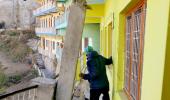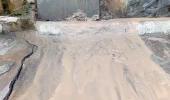Widening cracks in subsidence-hit Joshimath during the monsoon prompted authorities to shift five families to relief camps.

Admitting that land-subsidence in areas declared unsafe earlier this year seems to have been aggravated during the monsoon, Chamoli's disaster management officer NK Joshi said five families were shifted from Sunil ward to relief camps two days ago.
In January, land subsidence around Joshimath led to hundreds of residents fleeing their homes, which had developed cracks, and taking refuge in hotels, rest houses and at homes of relatives and friends.
Now, the recent heavy rain has sparked panic among the disaster-hit families of Joshimath.
The residents of Singhdhar, Gandhinagar and Sunil wards are worried the most due to the rain as subsidence is increasing in these areas that were earlier declared unsafe.
Information about the subsidence from the affected area of Sunil ward was received three days ago, following which five families were brought to the relief camp as a precautionary measure, Joshi said.
The retaining wall of an alternative road to Badrinath via the Narsingh temple also caved in about 10 days ago.
The subsidence is also aggravating from JP Colony in Marwari to Singhdhar ward, which suffered the maximum damage earlier this year.
Pratap Singh Chauhan, a former gram panchayat head who lives in the same area, said the pedestrian road between the Singhdhar ward's primary school and the Narsingh temple is almost completely in a state of collapse.
The size of the cracks above and below the road is gradually getting wider. It is the same area for which ISRO in January released a satellite image that was later withdrawn, Chauhan said.
A town of over 20,000 people in Uttarakhand's Chamoli district, Joshimath -- the gateway to Himalayan pilgrimage sites -- stands at a height of over 6,150 feet.










